height SUZUKI SWIFT 2000 1.G Transmission Service User Guide
[x] Cancel search | Manufacturer: SUZUKI, Model Year: 2000, Model line: SWIFT, Model: SUZUKI SWIFT 2000 1.GPages: 447, PDF Size: 10.54 MB
Page 320 of 447

9-16 BODY SERVICE
9) Apply primer for molding along molding surface all around.
10) Apply adhesive (1) referring to figure.
Adhesive amount specifications and position for wind-
shield
Width “a” : Approx. 7 mm (0.27 in.)
Height “b” : Approx. 15 mm (0.59 in.)
Position “c” : Approx. 10 mm (0.39 in.) for front, rear and
upper sections
Position “d” : Approx. 17 mm (0.67 in.) for bottom section.
11) Holding rubber sucker grips (1), place glass onto body by
aligning mating marks marked in step 3) and press it.
12) Check for water leakage by pouring water over windshield
through hose. If leakage is found, dry windshield and fill
leaky point with adhesive. If water still leaks even after that,
remove glass and start installation procedure all over again. NOTE:
Press glass (2) against fittings surface of body panel
quickly after adhesive (1) is applied.
Use of rubber sucker grip is helpful to hold and carry
glass after adhesive (1) is applied.
Perform steps 8) to 9) within 10 min. to ensure suffi-
cient adhesion.
Be sure to refer to adhesive maker’s instruction for
proper handling and drying time.
Start from bottom side of glass (2).
Be careful not to damage primer.
3. Molding
3
2
1
1“b”
“b”“b” “a”
“c”
“d”“c”
2
2
2
3
3
1
“a”“a”
NOTE:
Do not use high pressure water.
Do not blow compressed air directly at adhesive
applied part when drying.
Do not use infrared lamp or like for drying.
Page 321 of 447
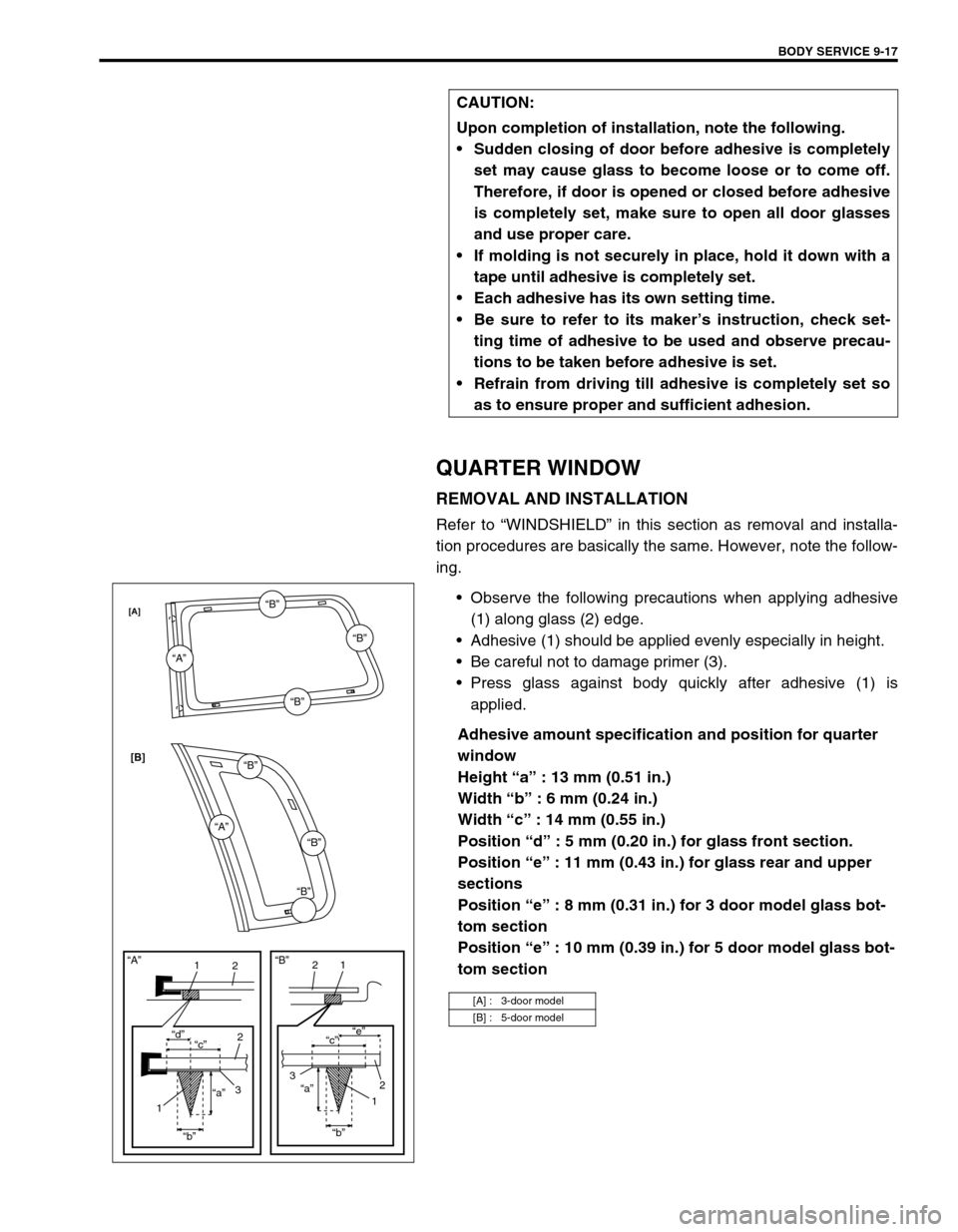
BODY SERVICE 9-17
QUARTER WINDOW
REMOVAL AND INSTALLATION
Refer to “WINDSHIELD” in this section as removal and installa-
tion procedures are basically the same. However, note the follow-
ing.
Observe the following precautions when applying adhesive
(1) along glass (2) edge.
Adhesive (1) should be applied evenly especially in height.
Be careful not to damage primer (3).
Press glass against body quickly after adhesive (1) is
applied.
Adhesive amount specification and position for quarter
window
Height “a” : 13 mm (0.51 in.)
Width “b” : 6 mm (0.24 in.)
Width “c” : 14 mm (0.55 in.)
Position “d” : 5 mm (0.20 in.) for glass front section.
Position “e” : 11 mm (0.43 in.) for glass rear and upper
sections
Position “e” : 8 mm (0.31 in.) for 3 door model glass bot-
tom section
Position “e” : 10 mm (0.39 in.) for 5 door model glass bot-
tom section CAUTION:
Upon completion of installation, note the following.
Sudden closing of door before adhesive is completely
set may cause glass to become loose or to come off.
Therefore, if door is opened or closed before adhesive
is completely set, make sure to open all door glasses
and use proper care.
If molding is not securely in place, hold it down with a
tape until adhesive is completely set.
Each adhesive has its own setting time.
Be sure to refer to its maker’s instruction, check set-
ting time of adhesive to be used and observe precau-
tions to be taken before adhesive is set.
Refrain from driving till adhesive is completely set so
as to ensure proper and sufficient adhesion.
[A] : 3-door model
[B] : 5-door model
“A”
“A”“B”
“B”
“B”
“B”
“B”“B”
11
22
2
33 “d”
“c”“c”“e”
“a”“a”
“b”“b”
11
2 “A”“B”
[A]
[B]
Page 322 of 447
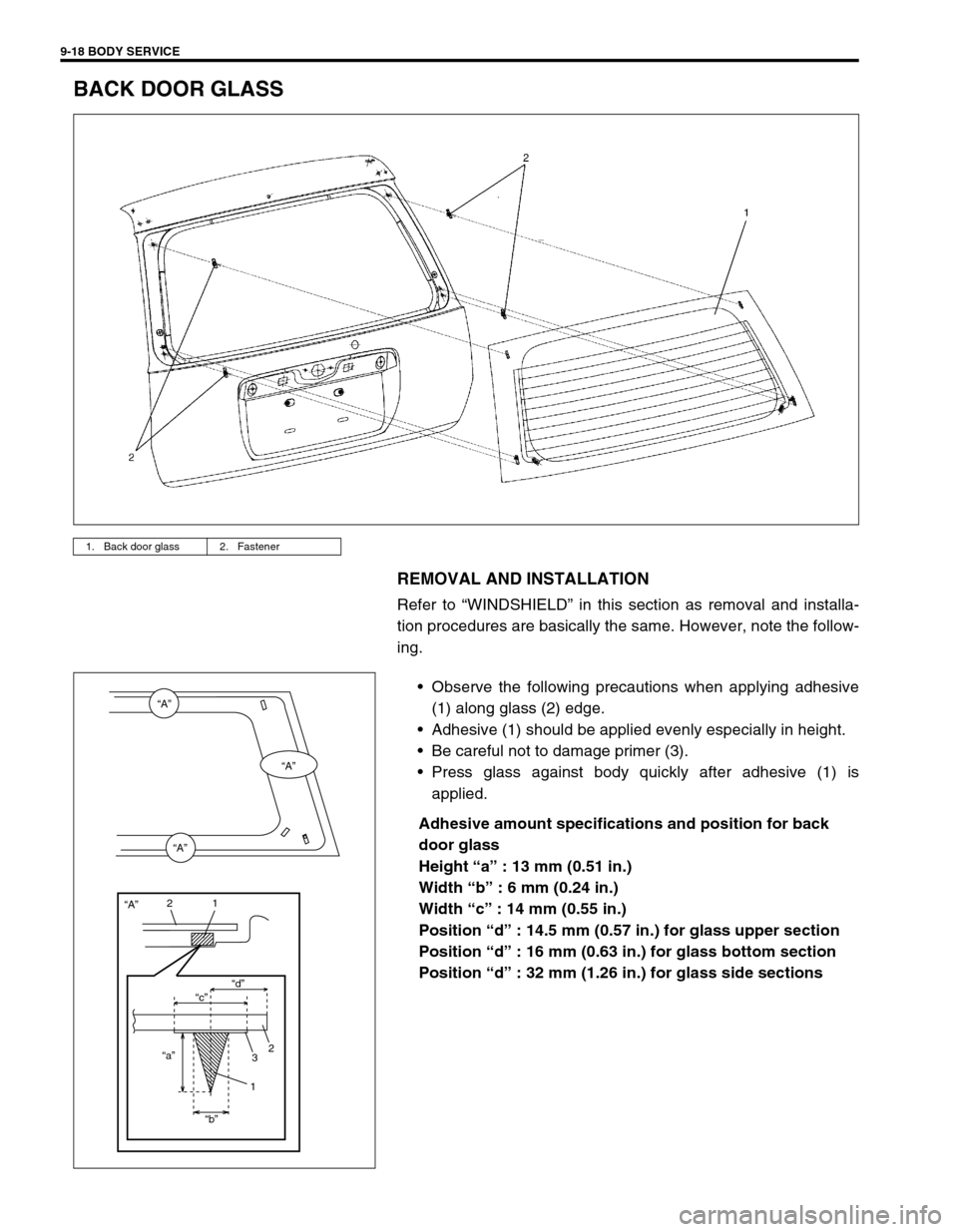
9-18 BODY SERVICE
BACK DOOR GLASS
REMOVAL AND INSTALLATION
Refer to “WINDSHIELD” in this section as removal and installa-
tion procedures are basically the same. However, note the follow-
ing.
Observe the following precautions when applying adhesive
(1) along glass (2) edge.
Adhesive (1) should be applied evenly especially in height.
Be careful not to damage primer (3).
Press glass against body quickly after adhesive (1) is
applied.
Adhesive amount specifications and position for back
door glass
Height “a” : 13 mm (0.51 in.)
Width “b” : 6 mm (0.24 in.)
Width “c” : 14 mm (0.55 in.)
Position “d” : 14.5 mm (0.57 in.) for glass upper section
Position “d” : 16 mm (0.63 in.) for glass bottom section
Position “d” : 32 mm (1.26 in.) for glass side sections
1. Back door glass 2. Fastener
“A”
“A”
“A”
“A”
“c”“d”
“a”
“b”
21
2
3
1
Page 372 of 447
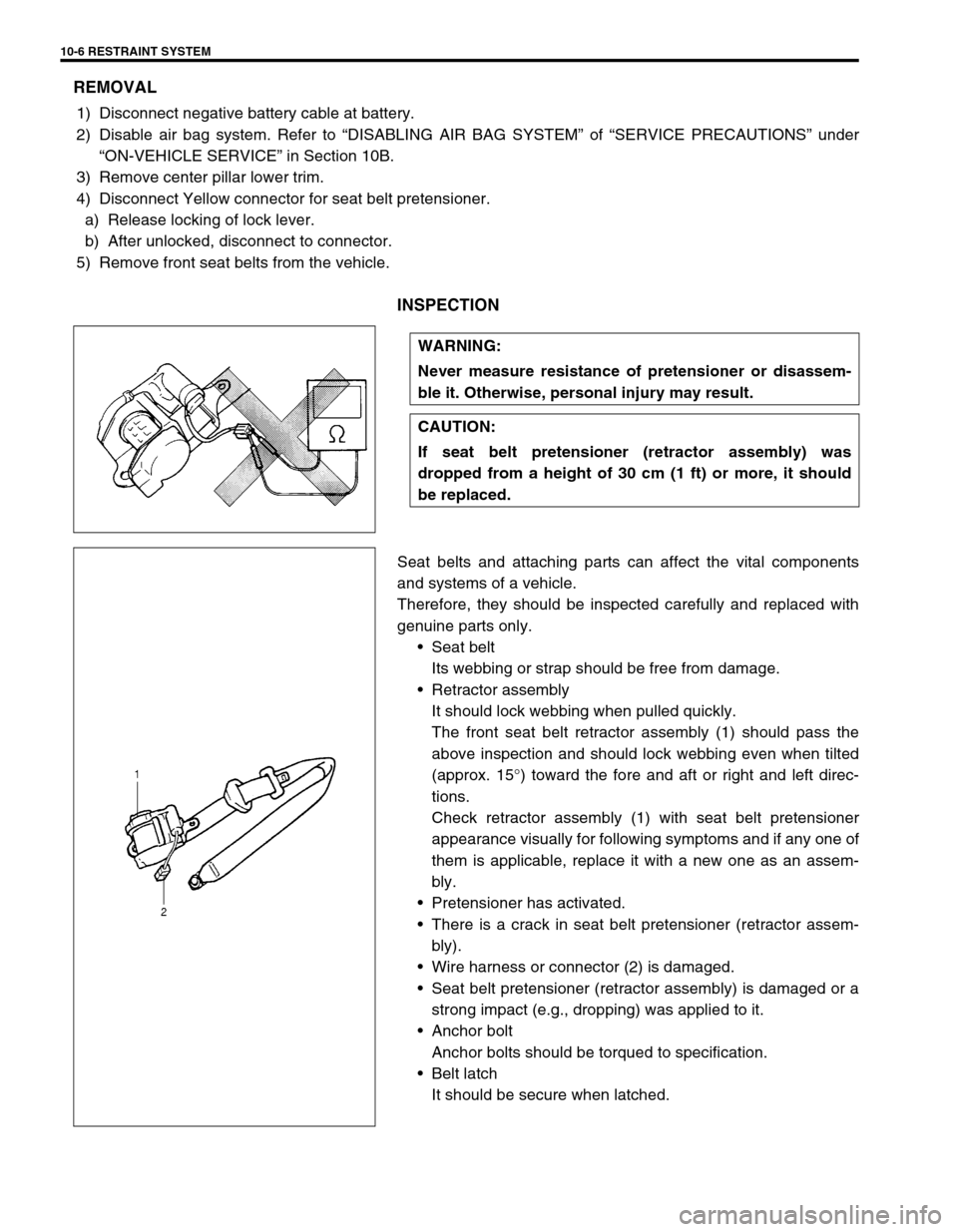
10-6 RESTRAINT SYSTEM
REMOVAL
1) Disconnect negative battery cable at battery.
2) Disable air bag system. Refer to “DISABLING AIR BAG SYSTEM” of “SERVICE PRECAUTIONS” under
“ON-VEHICLE SERVICE” in Section 10B.
3) Remove center pillar lower trim.
4) Disconnect Yellow connector for seat belt pretensioner.
a) Release locking of lock lever.
b) After unlocked, disconnect to connector.
5) Remove front seat belts from the vehicle.
INSPECTION
Seat belts and attaching parts can affect the vital components
and systems of a vehicle.
Therefore, they should be inspected carefully and replaced with
genuine parts only.
Seat belt
Its webbing or strap should be free from damage.
Retractor assembly
It should lock webbing when pulled quickly.
The front seat belt retractor assembly (1) should pass the
above inspection and should lock webbing even when tilted
(approx. 15°) toward the fore and aft or right and left direc-
tions.
Check retractor assembly (1) with seat belt pretensioner
appearance visually for following symptoms and if any one of
them is applicable, replace it with a new one as an assem-
bly.
Pretensioner has activated.
There is a crack in seat belt pretensioner (retractor assem-
bly).
Wire harness or connector (2) is damaged.
Seat belt pretensioner (retractor assembly) is damaged or a
strong impact (e.g., dropping) was applied to it.
Anchor bolt
Anchor bolts should be torqued to specification.
Belt latch
It should be secure when latched. WARNING:
Never measure resistance of pretensioner or disassem-
ble it. Otherwise, personal injury may result.
CAUTION:
If seat belt pretensioner (retractor assembly) was
dropped from a height of 30 cm (1 ft) or more, it should
be replaced.
Page 420 of 447
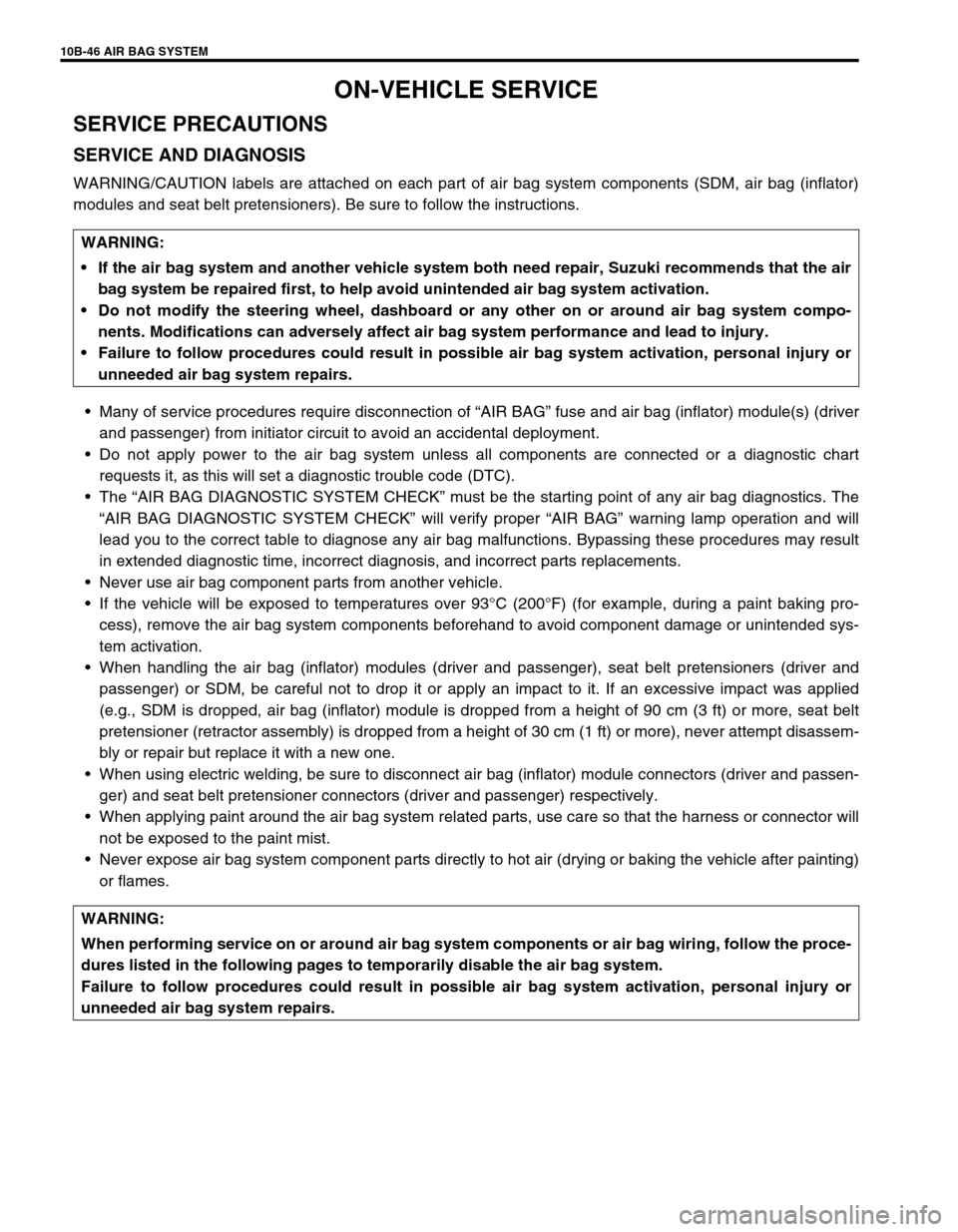
10B-46 AIR BAG SYSTEM
ON-VEHICLE SERVICE
SERVICE PRECAUTIONS
SERVICE AND DIAGNOSIS
WARNING/CAUTION labels are attached on each part of air bag system components (SDM, air bag (inflator)
modules and seat belt pretensioners). Be sure to follow the instructions.
Many of service procedures require disconnection of “AIR BAG” fuse and air bag (inflator) module(s) (driver
and passenger) from initiator circuit to avoid an accidental deployment.
Do not apply power to the air bag system unless all components are connected or a diagnostic chart
requests it, as this will set a diagnostic trouble code (DTC).
The “AIR BAG DIAGNOSTIC SYSTEM CHECK” must be the starting point of any air bag diagnostics. The
“AIR BAG DIAGNOSTIC SYSTEM CHECK” will verify proper “AIR BAG” warning lamp operation and will
lead you to the correct table to diagnose any air bag malfunctions. Bypassing these procedures may result
in extended diagnostic time, incorrect diagnosis, and incorrect parts replacements.
Never use air bag component parts from another vehicle.
If the vehicle will be exposed to temperatures over 93°C (200°F) (for example, during a paint baking pro-
cess), remove the air bag system components beforehand to avoid component damage or unintended sys-
tem activation.
When handling the air bag (inflator) modules (driver and passenger), seat belt pretensioners (driver and
passenger) or SDM, be careful not to drop it or apply an impact to it. If an excessive impact was applied
(e.g., SDM is dropped, air bag (inflator) module is dropped from a height of 90 cm (3 ft) or more, seat belt
pretensioner (retractor assembly) is dropped from a height of 30 cm (1 ft) or more), never attempt disassem-
bly or repair but replace it with a new one.
When using electric welding, be sure to disconnect air bag (inflator) module connectors (driver and passen-
ger) and seat belt pretensioner connectors (driver and passenger) respectively.
When applying paint around the air bag system related parts, use care so that the harness or connector will
not be exposed to the paint mist.
Never expose air bag system component parts directly to hot air (drying or baking the vehicle after painting)
or flames. WARNING:
If the air bag system and another vehicle system both need repair, Suzuki recommends that the air
bag system be repaired first, to help avoid unintended air bag system activation.
Do not modify the steering wheel, dashboard or any other on or around air bag system compo-
nents. Modifications can adversely affect air bag system performance and lead to injury.
Failure to follow procedures could result in possible air bag system activation, personal injury or
unneeded air bag system repairs.
WARNING:
When performing service on or around air bag system components or air bag wiring, follow the proce-
dures listed in the following pages to temporarily disable the air bag system.
Failure to follow procedures could result in possible air bag system activation, personal injury or
unneeded air bag system repairs.
Page 423 of 447

AIR BAG SYSTEM 10B-49
LIVE (UNDEPLOYED) AIR BAG (INFLATOR) MODULES
Special care is necessary when handling and storing a live (unde-
ployed) air bag (inflator) modules.
The rapid gas generation produced during deployment of the air
bag could cause the air bag (inflator) module, or an object in front
of the air bag (inflator) module, to be thrown through the air in the
unlikely event of an accidental deployment.
Never attempt disassembly of the air bag (inflator) modules.
If any abnormality is found, be sure to replace it with new
one as an assembly.
When an abnormality is noted as existing in the live (unde-
ployed) air bag (inflator) module, be sure to deploy it before
discarding it.
When grease, cleaning agent, oil, water, etc., got on the air
bag (inflator) modules (driver and passenger), wipe it off
immediately with a dry cloth.
If air bag (inflator) module was dropped from a height of 90
cm (3 ft) or more, it should be replaced with a new one as an
assembly. WARNING:
Never attempt to measure the resistance of the air bag
(inflator) modules (driver and passenger). It is very dan-
gerous as the electric current from the tester may deploy
the air bag.
WARNING:
For handling and storage of a live air bag (inflator)
module, select a place where the ambient temperature
below 65
°
°° °C (150
°
°° °F), without high humidity and away
from electric noise.
When carrying a live air bag (inflator) module, make
sure the bag opening is pointed away from you. In
case of an accidental deployment, the bag will then
deploy with minimal chance of injury. Never carry the
air bag (inflator) module by the wires or connector on
the underside of the module.
Otherwise, personal injury may result.
Page 424 of 447

10B-50 AIR BAG SYSTEM
LIVE (INACTIVATED) SEAT BELT PRETENSIONER
Special care is necessary when handling and storing a live (inac-
tivated) seat belt pretensioners.
Also, when the seat belt pretensioners activate, gas is generated
and the seat belt (1) is retracted into the retractor assembly (2)
quickly.
Note, therefore, that if they activate accidentally, the seat belt pre-
tensioners and other object(s) around them may be thrown
through the air.
Never attempt to disassemble the seat belt pretensioners
(retractor assembly).
If any abnormality is found, be sure to replace it with new
one as an assembly.
When an abnormality is noted as existing in the live (inacti-
vated) seat belt pretensioner, be sure to activate it before
discarding it.
When grease, cleaning agent oil, water, etc., got on the seat
belt pretensioners (retractor assembly), wipe it off immedi-
ately with a dry cloth.
If seat belt pretensioner was dropped from a height of 30 cm
(1 ft) or more, it should be replaced with a new one as an
assembly. WARNING:
When placing a live air bag (inflator) module on bench or
other surface, always face the bag up, away from the sur-
face. As the live passenger air bag (inflator) module must
be placed with its bag (trim cover) facing up, place it on
the workbench with a slit (1) or use the workbench vise
(2) to hold it securely at its lower mounting bracket (3).
It is also prohibited to place anything on top of the trim
cover and stack air bag (inflator) modules.
This is necessary so that a free space is provided to
allow the air bag to expand in the unlikely event of acci-
dental deployment.
Otherwise, personal injury may result.
1
2 3
WARNING:
Never attempt to measure the resistance of the seat belt
pretensioners. It is very dangerous as the electric current
from the tester may activate pretensioner.
Page 432 of 447
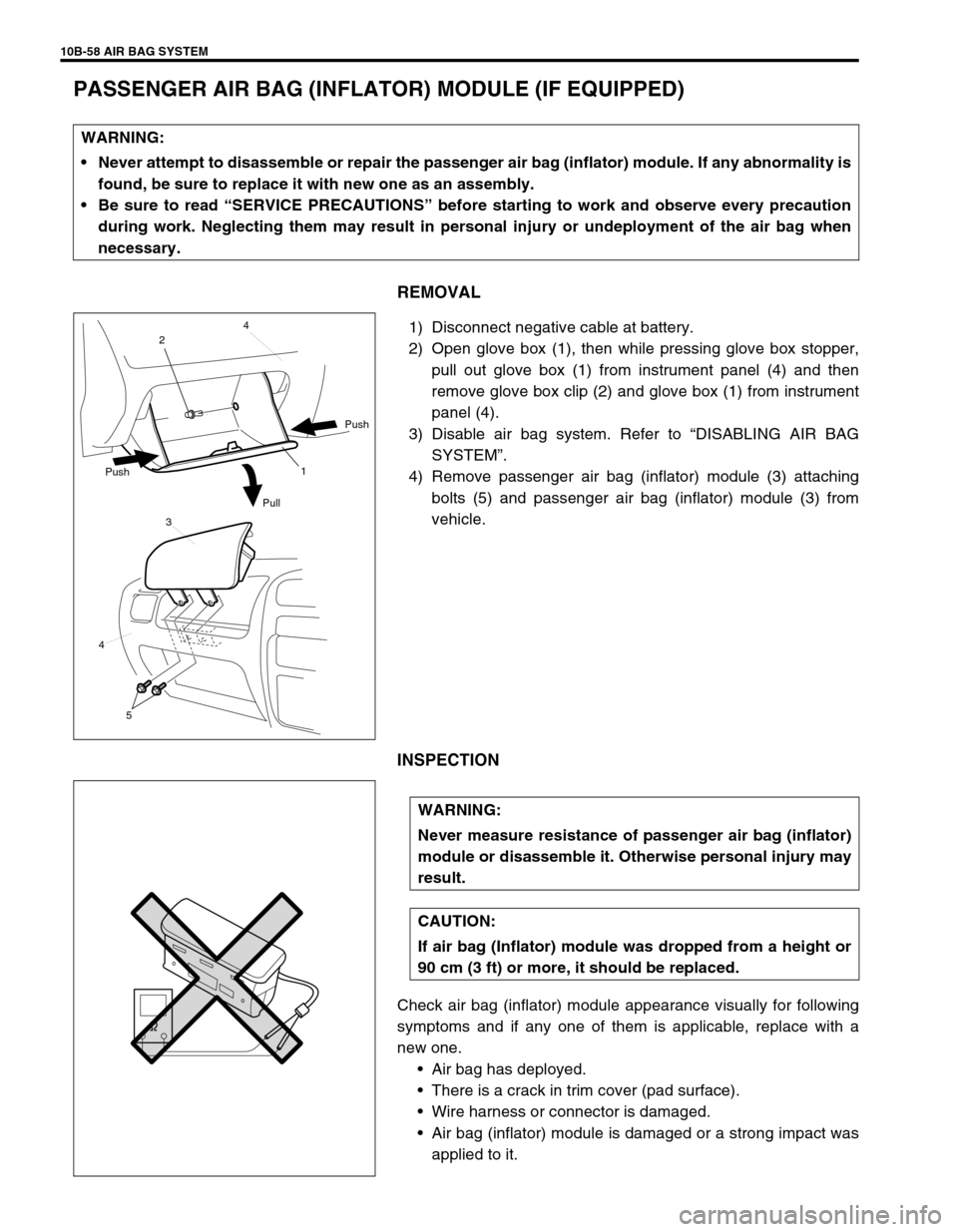
10B-58 AIR BAG SYSTEM
PASSENGER AIR BAG (INFLATOR) MODULE (IF EQUIPPED)
REMOVAL
1) Disconnect negative cable at battery.
2) Open glove box (1), then while pressing glove box stopper,
pull out glove box (1) from instrument panel (4) and then
remove glove box clip (2) and glove box (1) from instrument
panel (4).
3) Disable air bag system. Refer to “DISABLING AIR BAG
SYSTEM”.
4) Remove passenger air bag (inflator) module (3) attaching
bolts (5) and passenger air bag (inflator) module (3) from
vehicle.
INSPECTION
Check air bag (inflator) module appearance visually for following
symptoms and if any one of them is applicable, replace with a
new one.
Air bag has deployed.
There is a crack in trim cover (pad surface).
Wire harness or connector is damaged.
Air bag (inflator) module is damaged or a strong impact was
applied to it. WARNING:
Never attempt to disassemble or repair the passenger air bag (inflator) module. If any abnormality is
found, be sure to replace it with new one as an assembly.
Be sure to read “SERVICE PRECAUTIONS” before starting to work and observe every precaution
during work. Neglecting them may result in personal injury or undeployment of the air bag when
necessary.
1 24
Push
Pull Push
3
4
5
WARNING:
Never measure resistance of passenger air bag (inflator)
module or disassemble it. Otherwise personal injury may
result.
CAUTION:
If air bag (Inflator) module was dropped from a height or
90 cm (3 ft) or more, it should be replaced.